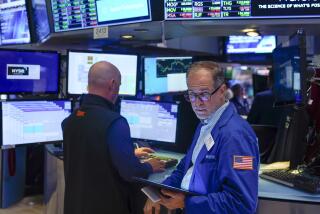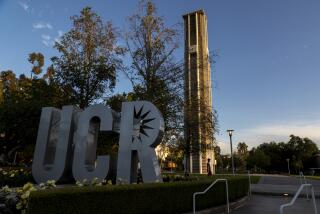Stock Research Is Hard on Upstarts
- Share via
NEW YORK — Scott Cleland’s timing appeared to be perfect when he launched an independent stock-research firm five years ago.
The 1990s bull market had ended, the government was preparing to crack down on tainted analysts and Cleland thought investors would clamor for conflict-free research.
He was wrong.
Although his firm was profitable, Cleland quietly fled the research business last month after concluding that it didn’t have much of a future.
“There have been tremendous changes in the investment management industry, and we no longer see the opportunities we originally saw five years ago,” Cleland said.
These are trying times for independent stock research.
A handful of firms are prospering, and demand for cutting-edge research is high. But many smaller start-ups are struggling to survive in a market that is increasingly dominated by big firms such as Standard & Poor’s Corp. and Morningstar Inc.
Securities regulators were hoping for a different outcome after their historic $1.4-billion settlement with Wall Street investment banks in April 2003. The banks were accused of pushing their analysts to tout weak stocks to curry favor with companies that could give them lucrative financing work.
Among other reforms, a dozen banks agreed to spend $460 million over five years on independent research, which they must distribute to clients for free alongside reports from their own analysts.
Free research was expected to be a boon to small investors, including those who have only a few thousand dollars in stocks. But many individuals are unaware that it exists, a recent survey suggests.
What’s more, the value of the free analysis has been diminished by more sophisticated practices that take stock analysis to new levels -- for example, scanning databases for kernels of information that institutional clients can use immediately in their trading strategies.
This new type of research is priced far out of the reach of the average shareholder, again leaving the little guy at a disadvantage to big institutional investors such as pension and mutual funds.
“If you believed that independent research was [going to be] the salvation of individual investors, then I don’t think it’s lived up to that,” said Michael Mayhew, chief executive of Integrity Research Associates, a Darien, Conn., consulting firm.
Still, independent research is much more available than in years past, and independents have a good stock-picking record.
Among firms tracking small-company stocks in the last two years, independents held half of the top 10 spots, including the first three, according to Investars.com, a website that follows analyst picks. Investars analyzed Wall Street investment banks and the larger independent researchers.
Even so, the 2003 pact hasn’t been the boon to small, independent research shops that some had expected.
Because investment banks had to provide independent research for every one of the hundreds of stocks they covered, that often meant hiring firms with big staffs, such as Standard & Poor’s, that were already doing large-scale research.
Some independents teamed up for wider coverage, but many players that followed only one or two industries were excluded. “A few firms have benefited significantly,” said Charlie Gepp, global head of research initiatives at Reuters Group. “But it hasn’t been the catalyst that some people expected it to be.”
Falling stock-trading commissions and new regulatory pressures have hurt independents by eating away at the industry’s payment structure.
Mutual funds and other institutions rarely buy research directly. Rather, they pay extra-high trading commissions to the banks, known as soft dollars, in return for research and other services.
But commissions are dropping steadily as cheaper computerized trading expands. And big investors have backed away from soft dollars as regulators have stepped up scrutiny for possible abuses. Critics have long worried that large investors use soft dollars on perks that had nothing to do with stock picking.
There are about 450 independent research firms today, but that is expected to drop to about 150 by 2009, according to Integrity Research. However, the revenue flowing to the surviving firms is expected to double from $1.5 billion in 2004 to $3.1 billion by 2009.
Small investors haven’t rallied around independent research even though they were the biggest victims of Wall Street’s bogus prognostications.
While Wall Street insiders typically knew to disregard chest-thumping “buy” recommendations, small investors often did not.
Many investors are unaware that independent research is available from Wall Street brokerages, according to an S&P; survey last year.
“Usage by the expected prime beneficiaries of the settlement, individual investors, is not as high as one might have thought it would be,” said a Lehman Bros. report to state regulators and the Securities and Exchange Commission.
Although they’ve complied with the settlement, investment banks haven’t played up the availability of outside research to clients, experts say.
“If I were Wall Street, I certainly wouldn’t want to put out really excellent independent research,” said Doug Atkin, chief executive of Majestic Research Corp. in New York.
Independent research reports have become more sophisticated over the years and are nearing parity with the detailed analyses and commentary prepared by investment banks to assess a stock’s prospects.
At the same time, however, a new tier of research has emerged to serve institutional clients. Some research firms give clients a chance to question expert sources directly, providing extensive rosters of authorities in various fields who can be tapped for insight. A biotech investor, for example, could query a scientist about a medical development.
Majestic Research, meanwhile, scours websites, government records and other data sources to cull hard-to-get information or analysis. But a basic subscription is about $80,000 a year, Atkin said.
“There is more information, and it’s less biased. That’s great,” Mayhew said. “The problem is individual investors don’t have the same access to high-quality information, and my guess is they never will.”
Wall Street firms began buying independent research in 2004. One big question is what will happen in 2009, when the obligation to underwrite independent analysis will end. It’s unclear how the fledgling industry will fare, experts say, when investors will have to pay for the alternative to the big banks’ research out of pocket.
Kenneth Shea, S&P;’s global equity research chief, believes a quality product will survive and thrive. “Although we benefit from the settlement,” he said, “we believe we’ll be in demand after the settlement.”
*
(BEGIN TEXT OF INFOBOX)
Independent edge
These are the annual returns for investors who followed each firm’s advice for stocks in the Russell 2,000 index for Feb. 1, 2004, to Feb. 1, 2006, based on a survey of large independent firms and major Wall Street brokerages.
Rate of return
Argus Research: 37.7%
Columbine Capital Services: 23.8%
Ford Equity Research: 21.0%
Deutsche Bank: 19.9%
Channel Trend: 15.8%
Smith Barney: 14.7%
Weiss Ratings: 14.2%
Thomas Weisel: 9.3%
UBS: 9.0%
Merrill Lynch: 6.9%
Source: Investars.com
More to Read
Inside the business of entertainment
The Wide Shot brings you news, analysis and insights on everything from streaming wars to production — and what it all means for the future.
You may occasionally receive promotional content from the Los Angeles Times.










